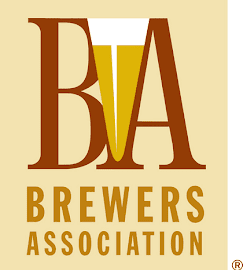Since 1997, Cask Marque has been ensuring that the cask ale you drink in pubs in the U.K. has been in perfect condition. Qualified assessors make over 20,000 visits to pubs each year in England, Scotland, Wales, and Europe to check the temperature, appearance, aroma, and taste of Britain’s favourite drink.—Cask Marque
Does your American pub (or brewery taproom or brewpub) serve a "great pint" of cask-ale? If so, you should know that Cask Marque accreditation IS now available for pubs and breweries in the United States.
In fact, Cask Marque has been assessing American pubs for several years, initially led by Paul Pendyck, a purveyor of cask-ale equipment in the U.S. and assisted by Alex Hall, a cask-ale partisan in New York. Both, by the way, are British expats.
Now, Steve Hamburg, one of the premier cellarmen in the U.S., has taken the reins as Cask Marque's USA Director and Chief Assessor.
****************
Criteria
What does it take for a pub (or brewery taproom or brewpub) to gain accreditation in the U.S.?First and foremost, as self-evident as this may sound, your pub must serve cask-ale every day, or close to it. Simply tossing a cask up on the bar once a week for Firkin Friday doesn't cut it.
After that, it's the big five criteria: temperature, aroma, taste, appearance, and cleanliness.
- Temperature of beer.
- Real ale 1 should be served, in the customer's glass, at between 11 and 13 °C. That's 51-55 °F. (And here in the U.S., we could lower that to 10 °C / 50 °F.) That's not warm, it's cellar cool: neither too cold to mask a beer's flavor nor too warm to rob a beer of refreshment. (Unfiltered beer that is served too cold can could also develop a 'chill haze' as proteins come out of solution, which speaks to 'clarity,' discussed below.)
- Aroma of beer.
- No evidence of staling, contamination, or otherwise off-aromas that don't belong in the beer as brewed.
- Clarity of beer.
- This one gets tricky. As classically presented in the U.K., cask-ales should be bright as a filtered beer without filtration. But American brewers often eschew clarity (and some UK brewers do as well). So, as with aroma, the clarity should be as the beer was brewed. No extraneous yeast or proteinaceous sludge.
- Flavor (& conditioning) of beer.
- Not gassy or foamy; not flat. No evidence of staling or age. The flavor should be representative of the beer as brewed; conditioning (carbonation) should be as the brewery intended.
- Cleanliness.
- A clean beer-cellar, clean beer-lines, clean beer-engine and/or tap, and beer-clean glassware. Of course.
- NO extraneous gas pressure
- NO gas pressure can be used to dispense from the cask, whether CO2, nitrogen, or whatever. That being stipulated, a cask breather 2 does not add pressure to a cask and, thus, a pub may employ one if it wishes. Using a cask breather is not a demerit: only badly served cask-ale is.

l-r: Paul Nunny —Director, Cask Marque (UK);
Steve Hamburg —USA Director, Chief US Assessor Cask Marque (US);
Paul Pendyck —Owner, UK Brewing Supplies (US).
At Craft Brewers Conference in Washington, D.C., 2017.
****************
Value to pub
Most pub owners are very money conscious, as, of course, they should be. And, yes, there is a nominal annual fee for Cask Marque accreditation, which helps defray the cost of the U.S. licensing fee and materials. Thus pub owners should view Cask Marque as a valuable value-added business-augmenter.It's a consultation: how to do things right so that customers return for repeat pours. It's an advertisement of achievement, just as a victory at the Great American Beer Festival would show brewing skill or a Cicerone accreditation highlight serving acumen. It's a public acknowledgment of a pub's (or brewery's or brewpub's) cask excellence and, thus, of the value to a customer. And it's not (yet) a common thing in the U.S.: again a mark of distinction for your pub or taproom.
For further details, and to arrange an assessment, contact Mr. Hamburg directly, via email: shamburg@cask-marque-americas.com.
Serving a great pint of cask-ale is not rocket science. But it does require care and attention to detail.
So, do it. Be that cask-ale hero. Get your pub its Cask Marque accreditation. That Cask Marque plaque is a damned nice thing to display.
-----more-----
- If your pub, brewery, or brewpub is in the southeast U.S., you could also contact me directly. Use the form to the bottom right of this entire page.
- A website for Cask Marque USA is in the works. Until then, contact Cask Marque US Chief Assessor Steve Hamburg via email.
- Website for Cask Marque in the U.K.: cask-marque.co.uk.
- The long-time director of Cask Marque UK is Paul Nunny (past Sales & Marketing Director at Adnams Brewery in the U.K.).
- 1 Technically speaking, cask-conditioned ale is not a brewing process but a serving process. Be that as it may, great importance should be given to brewing an ale suitable to be best served as cask-conditioned. Here's how the Campaign for Real Ale (CAMRA) —a cask-ale consumer organization based in the U.K.— puts it:
Real ale is a beer brewed from traditional ingredients (malted barley, hops, water, and yeast), matured by secondary fermentation in the container from which it is dispensed, and served without the use of extraneous carbon dioxide. Brewers use ingredients which are fresh and natural, resulting in a drink which tastes natural and full of flavour. It is literally living as it continues to ferment in the cask in your local pub, developing its flavour as it matures ready to be poured into your glass. Real ale has a natural taste full of flavour with a light natural carbonation (i.e fizziness) produced by the secondary fermentation that has occurred in the cask. A real ale should be served at 11 – 13C so that the flavour of the beer can be best appreciated. You can recognise real ale in a pub as it is usually served using a handpump. Real ale is also known as ‘cask-conditioned beer', ‘real cask ale', real beer' and ‘naturally conditioned beer.' The term ‘real ale' and the above definition were coined by CAMRA in the early 1970s.
- 2 Cask breather:
Sometimes called an "aspirator," a cask breather is a demand valve used in conjunction with a beer engine and a carbon dioxide tank for the dispense of cask-conditioned beers. It allows beer drawn from the cask to be replaced with the equivalent amount of sterile gas at ATMOSPHERIC PRESSURE [emphasis added]. This is a non-traditional and thus controversial method of dispensing cask conditioned ale [but] extensive taste testing has failed to demonstrate that the cask breather has any effect other than to extend the service life of a broached cask by an extra day or two.
— The Oxford Companion to Beer. Oxford University Press (2012). - For more from YFGF:
- Follow on Twitter: @Cizauskas.
- Like on Facebook: YoursForGoodFermentables.
- Follow on Flickr: Cizauskas.
- Follow on Instagram: @tcizauskas.










No comments:
Post a Comment
Comment here ...